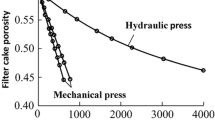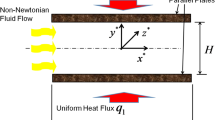Abstract
Machine learning approaches were used to predict and optimize the precipitation efficiency in the Bayer process. One thousand five hundred and sixty real operating data points of the precipitation efficiency from Iran Alumina Company were used for the model’s development. Radial basis function (RBF) and support vector machine (SVM) networks were applied to develop a black-box model of the process. The input parameters of the models were the concentrations of sodium oxide (Na2Oc) and aluminum oxide (Al2O3), tank temperature, ambient temperature, residence time, and solid content. To create an optimal model, a trial-and-error strategy based on analyzing all potential configurations was used. The network’s prediction performance is further demonstrated through model generalization inside the training data domain. The outcomes of both RBF and SVM networks demonstrate a good agreement between the industrial data and the model predicted values when considering statistical measures such as correlation coefficients of more than 0.99999, mean square errors, the absolute average deviation, and the absolute average relative deviation of less than 0.01%. The outcome of the models was used to optimize the operating parameters in such a way as to maximize precipitation efficiency with a minimum concentration of sodium oxide. The results show that the average precipitation efficiency of 42% was increased to 47% at optimized conditions.





Similar content being viewed by others
References
Andras PJNPL (2002) The equivalence of support vector machine and regularization neural networks. Neural Process Lett 15(2):97–104
Bahrami M, Nattaghi E, Movahedirad S, Ranjbarian S, Farhadi F (2012a) The agglomeration kinetics of aluminum hydroxide in Bayer process. Powder Technol 224:351–355
Bahrami M, Nattaghi E et al (2012) The agglomeration kinetics of aluminum hydroxide in Bayer process. Powder Technol 224:351–355
Barata PA, Serrano ML (1996) Salting-out precipitation of potassium dihydrogen phosphate (KDP) II. Influence of agitation intensity. J Cryst Growth 163:426–433
Baş D, Boyacı İH (2007) Modeling and optimization II: Comparison of estimation capabilities of response surface methodology with artificial neural networks in a biochemical reaction. J Food Eng 78(3):846–854
Bearne G, Dupuis M, Tarcy G (eds) (2016) Essential Readings in Light Metals: Volume 2 Aluminum Reduction Technology. Springer International Publishing, Cham. https://doi.org/10.1007/978-3-319-48156-2
Bl LÜ et al (2010) Effects of Na4EDTA and EDTA on seeded precipitation of sodium aluminate solution. Transact Nonferrous Met Soc China 20:s37–s41
Byvatov E, Fechner U, Sadowski J, Schneider G (2003) Comparison of support vector machine and artificial neural network systems for drug/nondrug classification. Inf Comput Sci 43(6): 1882–1889
Chelgani SC, Jorjani EJH (2009) Artificial neural network prediction of Al2O3 leaching recovery in the Bayer process—Jajarm alumina plant (Iran). Hydrometallurgy 97(1–2):105–110
Dorin R et al (1988) The electrodeposition of gallium from synthetic Bayer-process liquors. J Appl Electrochem 18(1):134–141
Đurić I et al (2012) Artificial neural network prediction of the aluminum extraction from bauxite in the Bayer process. J Serb Chem Soc 77(9):1259–1271
Ganguly S (2003) Prediction of VLE data using radial basis function network. Comput Chem Eng 27(10):1445–1454
Ghaemi A et al (2018) Processing, Comparing the capability of various models for predicting of the Bayer process parameters. J Adv Mater Process 6(1):71–86
Heidari E, Sobati MA, Movahedirad S (2016) Accurate prediction of nanofluid viscosity using a multilayer perceptron artificial neural network (MLP-ANN). Chemom Intell Lab Syst 155:73–85
Hind AR, Bhargava SK, Grocott SCJC (1999) Physicochemical, s.A., aspects, e., The surface chemistry of Bayer process solids: a review. 146(1–3): 359–374
Huang Wq et al (2019) Effect of lithium ion on seed precipitation from sodium aluminate solution. Transact Nonferrous Met Soc China 29(6):1323–1331
Hui-bin Yang et al. (2020) Characteristics of Sodium Oxalate Precipitates from the Bayer Precipitation Process. In: TRAVAUX 49, Proceedings of the 38th International ICSOBA Conference, China
Ilievski D, Livk IJCES (2006) An agglomeration efficiency model for gibbsite precipitation in a turbulently stirred vessel. Chem Eng Sci 61(6):2010–2022
Zeng J, Yin Z, Chen Q (2007) Intensification of precipitation of gibbsite from seeded caustic sodium aluminate liquor by seed activation and addition of crown ether. Hydrometallurgy 89(1–2):107–116
JingTao Y, Tan CL (2001) Guidelines for financial forecasting with neural networks, In: International Conference of Neural Information Processing, Shanghai, China
Liu G, Wu G, Chen W, Li X et al (2018) Increasing precipitation rate from sodium aluminate solution by adding active seed and ammonia. Hydrometallurgy 176:253–259
Liu Z et al (2020) Digestion behavior and removal of sulfur in high-sulfur bauxite during bayer process. Minerals Engineering 149:106237
Mahmoudian M, Ghaemi A, Hashemabadi H (2016) Prediction of red mud bound-soda losses in bayer process using neural networks. Iran J Chem Eng Spring 13:46–56
Mhurchú JN, Foley G (2006) Dead-end filtration of yeast suspensions: Correlating specific resistance and flux data using artificial neural networks. J Membr Sci 281(1–2):325–333
Misra C (2016) Agitation effects in precipitation. In: Donaldson D, Raahauge BE (eds) Essential readings in light metals. Springer International Publishing, Cham, pp 541–549. https://doi.org/10.1007/978-3-319-48176-0_75
Muhr H et al (1997) A rapid method for the determination of growth rate kinetic constants: application to the precipitation of aluminum trihydroxide. Ind Eng Chem Res 36(3):675–681
Ostap SJCMQ (1986) Control of silica in the Bayer process used for alumina production. Can Metall Q 25(2):101–106
Paspaliaris I, Panias D, Amanatidis A, Mordini J, Werner D, Panou G, Ballas D (1999a) Precipitation and calcination of monohydrate alumina from the Bayer process liquors. Eurothen 99:532–547
Paspaliaris I, Panias D, Amanatidis A, Mordini J, Werner D, Panou G, Ballas DJE (1999b) Precipitation and calcination of monohydrate alumina from the Bayer process liquors. 99:532–547
Paulaime AM, Seyssiecq I, Veesler SJPT (2003) The influence of organic additives on the crystallization and agglomeration of gibbsite. Powder Technol 130(1–3) 345–351
Rosenberg S (2017) Impurity removal in the bayer process. In: Travaux 46 proceedings of the 35th international ICSOBA conference, Hamburg, Germany, pp 175–196
Sahu NK, Sarangi CK, Tripathy BC, Bhattacharya IN, Satpathy BK (2014) Effect of urea on decomposition of sodium aluminate solution. J Taiwan Instit Chem Eng 45(3):815–822. https://doi.org/10.1016/j.jtice.2013.09.001
Sahu NK, Sarangi CK, Dash B, Tripathy BC, Satpathy BK, Meyrick D, Bhattacharya IN (2015) Role of hydrazine and hydrogen peroxide in aluminium hydroxide precipitation from sodium aluminate solution. Transact Nonferrous Met Soc China 25(2):615–621
Seecharran KR (2010) Bayer process chemistry. Alumina Plant, Guymine, Linden
Sidrak YLJI (2001) Dynamic simulation and control of the Bayer process. A review 40(4):1146–1156
Smeulders DE, Wilson MA et al. (2001) Insoluble organic compounds in the Bayer process. Ind Eng Chem Res 40(10): 2243–2251
Sonthalia R, Behara P, Kumaresan T et al. (2013) Review on alumina trihydrate precipitation mechanisms and effect of Bayer impurities on hydrate particle growth rate. Int J Miner 125: 137–148
Totten GE, Scott MacKenzie D (eds) (2003) Handbook of aluminum: alloy production and materials manufacturing. CRC Press. https://doi.org/10.1201/9780429223259
Totten GE, Scott MacKenzie D (eds) (2003) Handbook of aluminum: alloy production and materials manufacturing. CRC Press. https://doi.org/10.1201/9780429223259
Veesler S et al. (1994) General concepts of hydrargillite Al (OH) 3, agglomeration. J Cryst Growth 135(3–4): 505–512
Vogrin J et al. (2020) The anion effect on sodium aluminosilicates formed under Bayer process digestion conditions. Hydrometallurgy 192: 105236
Vt SE, Shin YC (1994) Radial basis function neural network for approximation and estimation of nonlinear stochastic dynamic systems 5(4): 594–603
Wellington M, Valcin F (2007) Impact of Bayer process liquor impurities on causticization. J Cryst Growth 46(15): 5094–5099
Yao J et al. (1999) Neural networks for technical analysis: a study on KLCI. IJTAF 2(02): 221–241
Yin J et al. (2006) Effects of monohydroxy-alcohol additives on the seeded agglomeration of sodium aluminate liquors. Light Met 3:153–157
Yu Hy et al. (2020) Effect of oxalate on seed precipitation of gibbsite from sodium aluminate solution. J Cent South Univ 27(3):772–779
Zeng, Js et al. (2008) Effect of tetracarbon additives on gibbsite precipitation from seeded sodium aluminate liquor. J Cent South Univ Technol 15(5): 622–626
Zhang Y, Zheng S, Du H, Xu H, Wang S, Zhang Y (2009) Improved precipitation of gibbsite from sodium aluminate solution by adding methanol. Hydrometallurgy 98(1–2):38–44
Zhang B, Pan X, Haiyan Y, Ganfeng T, Bi S (2018) Effect of organic impurity on seed precipitation in sodium aluminate solution. In: Martin O (ed) Light Metals 2018. Springer International Publishing, Cham, pp 41–47. https://doi.org/10.1007/978-3-319-72284-9_7
Zhang B et al. (2006) Influences of seed size and number on agglomeration in synthetic bayer liquors. J Cent South Univ Technol 13(5): 511–514
Zhang Y, Xu R, Tang H, Wang L et al. (2020) A review on approaches for hazardous organics removal from Bayer liquors 397: 122772
Zhou X, Yin J, Chen Y, Xia W, Xiang X, Yuan XJH (2018) Simultaneous removal of sulfur and iron by the seed precipitation of digestion solution for high-sulfur bauxite. Hydrometallurgy 181:7–15
Acknowledgements
The authors would like to express their gratitude to the Iran Alumina Company (IAC) for providing the operational data.
Author information
Authors and Affiliations
Corresponding author
Ethics declarations
Conflict of interest
On behalf of all authors, the corresponding author states that there is no conflict of interest.
Additional information
Publisher's Note
Springer Nature remains neutral with regard to jurisdictional claims in published maps and institutional affiliations.
Supplementary Information
Below is the link to the electronic supplementary material.
Rights and permissions
Springer Nature or its licensor (e.g. a society or other partner) holds exclusive rights to this article under a publishing agreement with the author(s) or other rightsholder(s); author self-archiving of the accepted manuscript version of this article is solely governed by the terms of such publishing agreement and applicable law.
About this article
Cite this article
Bakhtom, A., Ghasemzade Bariki, S., Movahedirad, S. et al. Machine learning-guided prediction and optimization of precipitation efficiency in the Bayer process. Chem. Pap. 77, 2509–2524 (2023). https://doi.org/10.1007/s11696-022-02642-x
Received:
Accepted:
Published:
Issue Date:
DOI: https://doi.org/10.1007/s11696-022-02642-x




